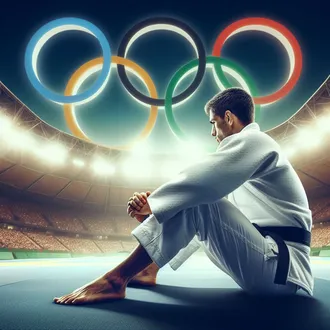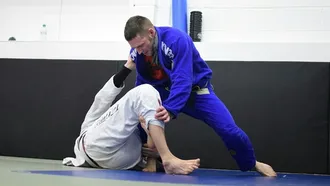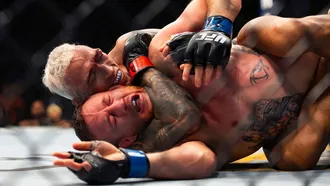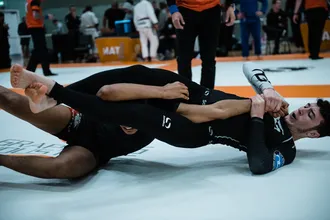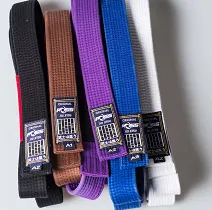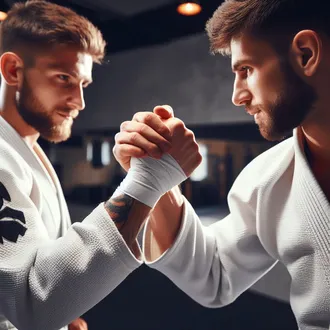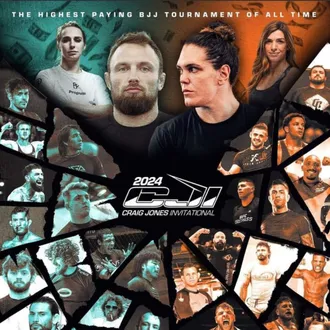
Hey there, Jiu-Jitsu enthusiasts! If you've spent time in the Brazilian Jiu-Jitsu (BJJ) or combat sports community, you may have noticed some fighters with a distinct ear condition known as "cauliflower ear."
But what exactly is cauliflower ear? How does it develop, why is it so common in grappling, and most importantly, how can you prevent it?
Can You Get Cauliflower Ear from BJJ?
Yes, cauliflower ear can develop from BJJ, but it's not extremely common unless you're training frequently, rolling intensely, and neglecting ear protection.
Cauliflower ear occurs when the ear experiences repeated trauma—getting hit, folded, or compressed; causing blood to pool beneath the skin. If left untreated, this leads to hardening and the characteristic swollen, lumpy appearance.
While some see it as a badge of honor in grappling sports, many prefer to avoid it. Wearing protective headgear and addressing any swelling early can significantly reduce the risk.
Unless you're training hard every day, it's not something to worry about too much—but staying aware and taking preventive steps is always a good idea!
The Science Behind Cauliflower Ear
Let’s take a closer look at the science behind cauliflower ear. According to medical literature, cauliflower ear—also known as auricular hematoma—occurs when the ear suffers trauma or repetitive impact. This damage causes blood to collect between the cartilage and the skin, creating a hematoma.
If the trapped blood isn't drained quickly, the healing process is disrupted, depriving the cartilage of essential nutrients. Over time, this can lead to cartilage death, resulting in a hardened, shriveled, and lumpy appearance—resembling a cauliflower.
A Timeline: From Impact to Reshape
Initial Trauma (0-24 Hours)
Cauliflower ear begins with trauma. The outer part of the ear, known as the auricle or pinna, is made up of a thin layer of skin over flexible cartilage. When the ear is struck, compressed, or experiences repeated friction, small blood vessels (capillaries) can rupture, leading to internal bleeding.
Hematoma Formation (24-48 Hours)
As blood vessels rupture, blood accumulates between the skin and ear cartilage, forming a hematoma. Hematomas are the body's natural response to injury, sending blood to the damaged area. However, since the ear has limited space, this trapped blood causes swelling, pain, and pressure buildup.
Cartilage Starvation (48-72 Hours)
Cartilage is avascular, meaning it lacks a direct blood supply and relies on surrounding skin for oxygen and nutrients. When a hematoma blocks this connection, the cartilage becomes deprived of essential nourishment, increasing the risk of tissue damage.
Necrosis and Fibrosis (1-2 Weeks)
Without proper blood flow, the cartilage begins to die—a process called necrosis. In response, the body produces fibrous tissue to replace the damaged cartilage. This scar tissue is denser and less flexible, altering the ear's natural shape.
Permanent Deformity (2-4 Weeks)
Over time, as more cartilage is replaced by fibrous tissue, the ear becomes lumpy and hardened, taking on the distinct cauliflower-like appearance. Since cartilage has minimal regenerative ability, these changes are often permanent without medical intervention.
Potential Complications (Long-Term)
When left untreated, cauliflower ear can lead to serious complications. Blood buildup may become infected, causing abscess formation. In severe cases, excessive scar tissue can alter the shape of the ear canal, potentially leading to hearing issues.
These risks highlight the importance of early treatment to prevent permanent deformity and maintain ear function.
Why is Cauliflower Ear Common in BJJ and MMA?
Now, you might wonder, why do grapplers and MMA fighters get cauliflower ear? The answer lies in the nature of these sports.
Brazilian Jiu-Jitsu involves a lot of full contact from takedowns to ground work. These exchanges place the ears in the line of fire, so to speak. Whether it's an accidental elbow while rolling, the friction from rubbing against the gi, or the pressure from a tight headlock, the ears take quite a beating.
Over a long period of time, this repeated friction can lead to developing cauliflower ear.
Why Is Cauliflower Ear Common in BJJ and MMA?
Why do Brazilian Jiu-Jitsu (BJJ) and MMA fighters frequently develop cauliflower ear? The answer lies in the nature of these sports.
BJJ is a high-contact martial art that involves intense grappling, takedowns, and ground fighting. These repeated exchanges put the ears at risk of direct trauma. Whether from an accidental elbow during rolling, friction against the gi, or sustained pressure from a tight headlock, the ears endure repeated impact.
Over time, this continuous friction and compression can lead to cauliflower ear in BJJ and MMA, especially for athletes who train frequently and do not take preventive measures.
Grappling Exchanges That Increase the Risk of Cauliflower Ear
Guard Play
When you're playing guard, especially closed guard, training partners often try to posture up and break free. During this process, they may push against your head or ears, leading to direct trauma and increasing the risk of hematoma formation.
Scrambles
Quick positional transitions during BJJ scrambles can cause ears to be caught, twisted, or crushed against the mat or an opponent’s body, creating repeated stress on the cartilage.
Takedowns and Takedown Defense
Whether executing a double-leg takedown or defending against one, the ears can suffer significant impact. When driving forward for a takedown, the side of the head—including the ears—may rub aggressively against an opponent, leading to irritation and potential hematoma formation.
Side Control and Crossface Pressure
In side control, many practitioners use crossface pressure to control their opponent’s head. This involves driving the shoulder into the opponent’s face, which can compress the ear, leading to trauma over time.
Gi Chokes and Collar Manipulations
In gi-based Brazilian Jiu-Jitsu, opponents may use the gi collar for chokes and positional control. Tightening or pulling the gi collar around the neck may press against the ear cartilage, causing repeated irritation.
Headlocks and Guillotine Chokes
Techniques like the guillotine choke and various headlocks involve wrapping an arm around the opponent’s head. If applied tightly or with twisting pressure, this can lead to intense ear compression, increasing the risk of cauliflower ear.
Mount Position
When an opponent establishes mount control, they use their weight and positional dominance to pin you down. If you turn to escape, your ear may be pressed into the mat, leading to trauma over time.
Stack Passes
During stack passes, the bottom player’s legs and hips are lifted, folding them onto their own neck and shoulders. This movement can cause the ears to be crushed between the mat and the practitioner's body, increasing the likelihood of injury.
MMA Striking
For MMA fighters, the risk of cauliflower ear is even greater due to striking damage. Unlike pure BJJ, MMA includes punches, elbows, and kicks, which directly impact the ears. These repeated strikes accelerate blood pooling under the skin, leading to faster cartilage damage.
Is Cauliflower Ear a Badge of Honor?
Beyond the medical risks, cauliflower ear carries cultural significance in the BJJ and MMA communities. For many practitioners, it is seen as a symbol of dedication, a mark of time spent on the mats, and a visual sign of experience in combat sports.
In Brazilian Jiu-Jitsu, wrestlers and grapplers with cauliflower ear are often recognized as battle-tested competitors. Some even wear it with pride, believing it represents their hard work and perseverance. Legendary fighters like Randy Couture and Khabib Nurmagomedov are known for their distinctively hardened ears, reinforcing the idea that it's a warrior's mark.
However, not everyone embraces this look. Many BJJ athletes take preventative measures to avoid permanent ear damage, using headgear or treating swelling early. Some even opt for medical treatment to reverse the effects.
Ultimately, whether you see cauliflower ear as a badge of honor or something to avoid is a personal choice. What matters most is making an informed decision about your health and longevity in the sport.
How to Prevent Cauliflower Ear in BJJ
Now that we understand how cauliflower ear develops, how can you protect yourself during BJJ and MMA training? The best way to avoid long-term ear damage is through preventative measures. Here are the key steps to take:
Wear Ear Protection
In sports like wrestling and BJJ, where ear trauma is common, wearing ear guards or headgear is highly recommended. This protective equipment helps distribute impact forces, reducing direct trauma to the ears. If you already have minor swelling or previous damage, headgear can also prevent further injury.
Stay Aware During Rolling
While it's impossible to anticipate every movement from your opponent, maintaining awareness can minimize ear trauma. If you feel excessive pressure on your head—such as from a tight guillotine choke or crossface pressure—adjusting your position quickly can reduce direct strain on the ears.
Maintain Proper Hygiene
Although infections don’t directly cause cauliflower ear, they can worsen swelling and prolong healing. Make sure to:
- Clean your ears after training.
- Wear clean training gear to reduce bacterial exposure.
- Train on sanitized mats to prevent skin infections like staph or MRSA.
Treatment for Cauliflower Ear
If you suspect you have developed cauliflower ear, early treatment is crucial to prevent permanent damage. Here’s what you need to know:
Seek Immediate Medical Attention
If you notice swelling, tenderness, or fluid buildup in your ear, seek medical attention as soon as possible. The faster the blood is drained, the better your chances of preventing long-term cartilage damage.
Draining the Ear (Aspiration)
A common treatment for auricular hematoma involves using a sterile needle or syringe to drain the trapped blood. This must be performed by a medical professional to prevent infection and complications.
Applying Compression Dressings
After drainage, doctors often apply a compression dressing to prevent the space from refilling with blood. This bandage should remain in place for several days to allow proper healing.
Using Medications
In some cases, antibiotics are prescribed to prevent infections, especially if there was an open wound. Anti-inflammatory medication can also help reduce swelling and pain.
Surgical Intervention
If cauliflower ear becomes chronic, surgical correction may be necessary. This can involve removing hardened tissue and reconstructing the ear to restore a more natural shape.
By understanding both prevention and treatment options, you can make informed decisions about protecting your ears while training. While some athletes consider cauliflower ear a badge of honor, prioritizing your health and well-being should always come first.
Whether you embrace the scars of battle or take steps to prevent them, the most important thing is to enjoy the art and sport of Brazilian Jiu-Jitsu safely!
Frequently Asked Questions (FAQ)
Can you get cauliflower ear from BJJ?
Yes, but it's not as common as people think. Most BJJ practitioners never develop cauliflower ear unless they train very frequently, experience high-impact grappling exchanges, or ignore early symptoms. Wearing protective gear and treating swelling early can significantly reduce the risk.
Does BJJ cause cauliflower ear?
BJJ itself doesn’t "cause" cauliflower ear, but the nature of grappling means that repeated friction, pressure, and impact can lead to ear trauma over time. It mostly affects competitors who train at a high intensity without protection.
How does BJJ cause cauliflower ear?
Cauliflower ear develops when the ear experiences repeated trauma from friction, impacts, or sustained pressure. Techniques like headlocks, guillotine chokes, and crossface pressure increase the risk, especially during aggressive training or competition.
What causes cauliflower ear in BJJ?
Cauliflower ear is caused by repeated trauma to the ear, leading to blood pooling between the skin and cartilage. In BJJ, this typically happens due to takedowns, headlocks, crossface pressure, and friction from rolling. However, it usually takes consistent trauma over time to become a problem.
Can you train BJJ without getting cauliflower ear?
Yes! Many practitioners train BJJ without cauliflower ear by taking preventive measures like wearing protective headgear, avoiding excessive friction against the mat or gi, and treating any hematoma before it hardens into permanent scar tissue.
How can you prevent cauliflower ear in BJJ?
The best way to prevent cauliflower ear in BJJ is by wearing ear guards or headgear during training, especially in high-contact sessions. Additionally, staying aware of head pressure during rolling and treating any early swelling immediately can significantly reduce the risk.
How do you stop cauliflower ear from forming?
The best way to stop cauliflower ear from forming is to recognize the early signs (swelling and tenderness) and drain the blood immediately before it hardens into scar tissue. Wearing protective BJJ headgear can also prevent further trauma.
How do you deal with cauliflower ear from BJJ?
If you develop an auricular hematoma, it’s crucial to drain the blood within 24-48 hours. Seek medical attention for proper drainage, compression, and possible antibiotic treatment. If untreated, it can harden into permanent scar tissue.
Wrapping Up
So, there you have it! Cauliflower ear is a common sight in the BJJ and MMA world, caused by repeated trauma to the ear. While some athletes see it as a badge of honor, many prefer to take preventive measures to protect against permanent ear damage.
Regardless of your stance on the topic, being informed is key. Whether you embrace the battle scars or choose to safeguard your ears, understanding the risks and available treatments allows you to make the best decision for your long-term health.
At the end of the day, BJJ isn’t just about physical battles—it’s about technical mastery, body awareness, and longevity in the sport.
Roll safe and take care of those ears!
